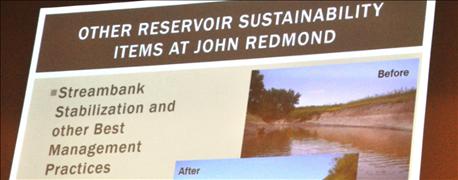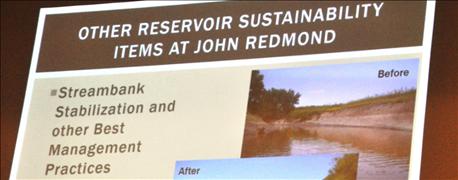
A big question looms in the near future for the Kansas Water Office with the completion of Phase 1 of dredging on the John Redmond Reservoir: Should they just keep going?
The $19.5 million Phase 1 project was completed using bonds issued for the project through the Kansas Department of Agriculture Division of Water Resources and will be retired with Kansas Water Office funds.
But the Phase 1 project only removed a tiny fraction of what needs to be removed from the lake in order to ensure that the water supply lasts through 2045 — the year that the operating contract ends for Wolf Creek Nuclear Power Plant, a very important industrial customer for John Redmond water.

ADDED MEASURES: This slide from the Governor's Conference on the Future of Water in Kansas depicts the success of streambank stabilization in reducing the amount of sediment entering reservoirs. John Redmond has lost about 40% of its storage capacity to sedimentation.
The rate of sedimentation of John Redmond is estimated at about 760 acre-feet of storage per year. Phase 1 restored about 1,900 acre-feet of storage — enough to offset about three years of sedimentation and perhaps more if several streambank stabilization projects, either in progress or in planning stages, are successful in slowing the sedimentation rate.
"Several phases of dredging will be needed, and we are evaluating Phase 2 with an eye to how much cost savings could be achieved if we were able to roll immediately into a second phase," says Matt Unruh, who oversaw the Phase 1 project for the Kansas Water Office.
One savings would be the cost of demobilizing the Great Lakes Dredge and Dock machinery that is still on the site.
The infrastructure could be modified to dredge a second area for much less money than it would take to re-assemble it for a second phase of dredging three or more years from now. Likewise, rolling into an immediate Phase 2 project would save the cost of mobilizing all the equipment and infrastructure a second time.
"There is no doubt that rolling into an immediate Phase 2 would save several millions of dollars," says Earl Lewis, assistant director of the KWO.
There is however, the question of where the several million dollars needed to complete a second phase would come from.
The state is already looking at a projected revenue shortfall in the coming year of more than $340 million, and any added project, regardless of its value, could prove a hard sell.
About the Author(s)
You May Also Like






